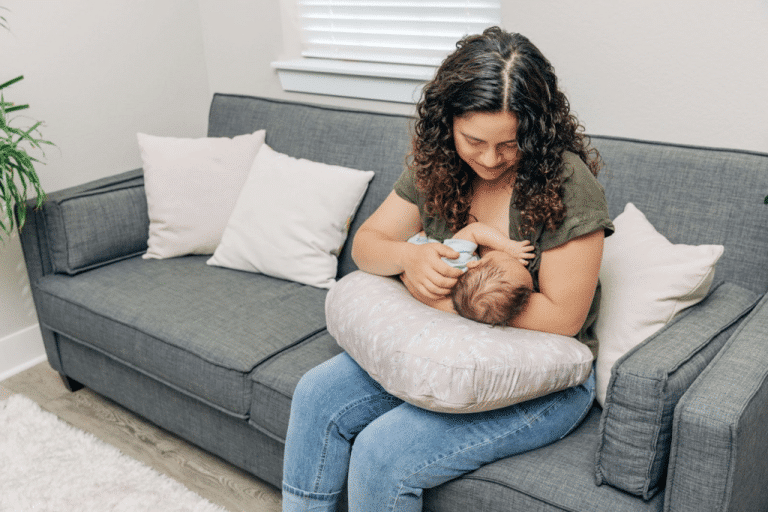As your baby approaches their first birthday, you may suddenly find yourself faced with the dreaded 11-month sleep regression.
This phase can be exhausting and frustrating for parents who thought they had finally established a peaceful sleep routine.
Your once-perfect sleeper may now wake frequently, fight naps, and become fussy at bedtime.
Rest assured, you’re not alone in this struggle. The 11-month sleep regression is a common developmental milestone that many families experience.
In this guide, we’ll explore the reasons behind this regression and provide you with practical strategies to help your baby (and you) get through this challenging period.
With patience, consistency, and a few key techniques, you’ll be able to successfully manage this phase and restore the restful nights you and your little one deserve.
What Is Sleep Regression?
A temporary phase of disrupted sleep patterns often seen in babies and toddlers, usually linked to developmental leaps and characterized by more frequent night wakings and changes in napping habits.
Sleep regression for an 11-month-old baby refers to any disturbance in their normal sleep patterns.
At this age, most babies sleep around 12-16 hours a day, including naps.
However, various factors can interfere with their sleep, causing them to wake up more frequently or struggle to fall asleep.
What Causes Sleep Regressions At 11 Months?
- Sleep Pattern Development: At 11 months, babies experience big changes that can shake up their sleep patterns. Their growing brains and bodies are busy developing new skills and understanding the world around them.
- Separation Anxiety: Separation anxiety often peaks during this time. Your little one becomes more aware of your presence and absence. This emotional development can make bedtime challenging and cause frequent night-waking.
- Teething Troubles: Teething continues to be a significant disruptor. Sharp teeth pushing through tender gums create uncomfortable sensations. Your baby might feel pain that makes falling asleep difficult.
- Increased Mobility: Physical milestones play a huge role in sleep regressions. Babies are mastering crawling, pulling up, and potentially taking their first steps. These skills can make their minds too active for peaceful rest.
- Changes in Daytime Sleep Needs: Daytime sleep needs are shifting. Your baby might be dropping from two naps to one. This transition can create temporary sleep confusion and impact nighttime rest.
How Long Does the 11-Month Sleep Regression Last?
Parents often wonder how long this challenging phase will last.
The truth is that sleep disruptions at 11 months can feel like an eternity when you’re in the midst of them, but they’re typically a short-lived challenge.
Most sleep regressions last between four to six days, though some can extend to two weeks. The duration depends on multiple factors that impact your baby’s sleep patterns.
Developmental milestones play a significant role – as your little one learns new skills like crawling, standing, or attempting to communicate, their sleep might become more fragmented.
Can 11-Month-Old Babies Experience Naptime Challenges?
At 11 months, babies experience significant developmental shifts that directly impact their daytime rest.
- Nap Resistance: Nap resistance becomes common as active and curious infants fight sleep due to newfound mobility and exploration.
- Adjusting Wake Times: By carefully extending the time between waking and napping, you create enough sleep pressure for a smoother transition.
- Nap Transitions: Many babies shift from three naps to two during this stage, which can create temporary sleep disruptions. This natural progression requires parents to be patient and flexible.
5 Tips for Managing Sleep Challenges at 11 Months
1. Adjust Sleep Expectations
At 11 months, your baby’s sleep needs may change. They might need fewer naps or longer wake periods. Pay attention to their natural rhythm and adjust their schedule to match it.
2. Establish a Secure Sleep Environment
Create a calming sleep space. Use soft lighting, white noise, or a cozy blanket to make the area feel safe and relaxing. A predictable environment helps your baby wind down.
3. Allow for Daytime Play
Active play during the day helps your baby use up energy. Crawling, exploring, and playing make it easier for them to sleep well at night.
4. Encourage Self-Soothing
Help your baby learn to fall asleep on their own. Slowly reduce sleep associations like rocking or feeding to sleep. This builds confidence and independence.
5. Offer Comfort During Developmental Leaps
Growth spurts or new skills can disrupt sleep. Be there to comfort your baby, but avoid creating habits that might be hard to break later.
Sleep Schedule Template
To make tracking your baby’s sleep patterns easier and more effective, we’ve created a Sleep Schedule Template.
This tool will help you monitor your baby’s sleep progress, identify patterns, and adjust their schedule for more restful nights.
| Date | Wake Up Time | Nap 1 Start | Nap 1 End | Nap 2 Start | Nap 2 End | Bedtime | Total Sleep Hours | Sleep Quality (1-5) |
|---|---|---|---|---|---|---|---|---|
| 01/01/2025 | 7:00 AM | 9:30 AM | 10:30 AM | 2:00 PM | 3:00 PM | 7:30 PM | 13 hours | 4 |
| 01/02/2025 | 7:15 AM | 10:00 AM | 11:00 AM | 2:30 PM | 3:30 PM | 8:00 PM | 12 hours | 3 |
| 01/03/2025 | 6:45 AM | 9:00 AM | 10:00 AM | 1:45 PM | 2:45 PM | 7:00 PM | 11 hours | 4 |
| 01/04/2025 | 7:30 AM | 10:15 AM | 11:15 AM | 3:00 PM | 4:00 PM | 8:15 PM | 12.5 hours | 5 |
Instructions
- Wake-Up Time: Record the time your baby wakes up in the morning.
- Nap Start & End: Track the start and end times for both naps. This will help you understand if daytime sleep is influencing nighttime rest.
- Bedtime: Note the time when your baby goes to bed at night.
- Total Sleep Hours: Add up the total sleep time (naps + nighttime sleep).
- Sleep Quality (1-5): Rate your baby’s sleep quality from 1 to 5, with 1 being restless and 5 being peaceful.
How to Use
- Track Regularly: Fill out this chart daily to keep track of your baby’s sleep habits.
- Look for Patterns: After a few days or weeks, review the chart to see if there are any patterns—such as nap duration affecting nighttime sleep or specific times when your baby struggles to fall asleep.
- Adjust Sleep Schedule: Use the information to tweak your baby’s sleep schedule as needed for better rest.
Conclusion
The 11-month sleep regression can be challenging, but it’s a normal part of your baby’s development.
This phase typically lasts a few weeks. Adjusting nap times and creating a calming bedtime environment can help ease the transition.
Every baby is different, so flexibility and patience are key. It’s okay to experiment with different approaches to find what works best for your family.
Remember, this phase will pass. Provide comfort, stay consistent, and seek support if needed. With a positive mindset, better sleep days will be here soon!
Frequently Asked Questions
Is There a Developmental Leap at 11 Months?
Yes, there is a developmental leap at 11 months, including improved physical skills and cognitive abilities.
How Long Should I Let My 11-Month-Old Cry It Out?
Letting an 11-month-old cry it out is not recommended. Instead, try gentler sleep-training methods and consult your pediatrician.
Why Is My 11-Month-Old Suddenly So Fussy?
An 11-month-old may be fussy due to teething, separation anxiety, or developmental changes. Offer comfort and check for signs of illness.
What Is a Good Bedtime for An 11-Month-Old?
A good bedtime for an 11-month-old is typically between 6:30 pm and 8:30 pm, depending on their sleep schedule and individual needs.












